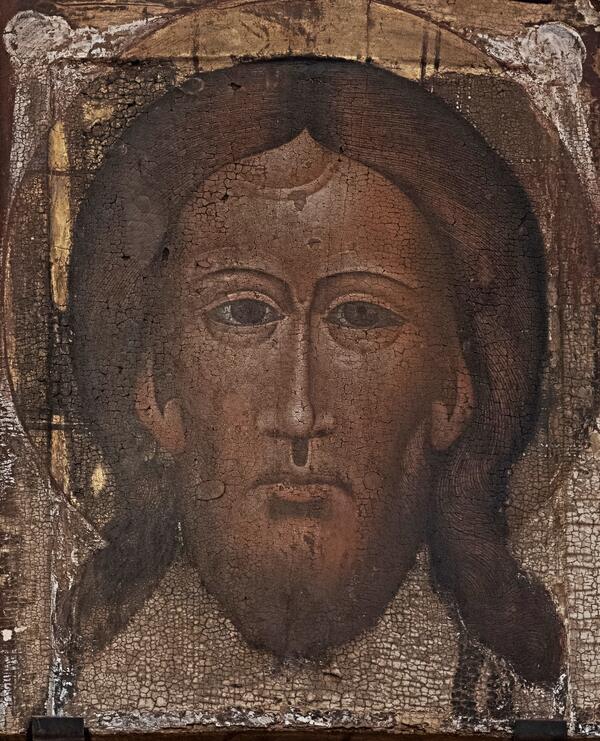The icon of the Mandylion of Edessa, or the Savior ‘not made by human hands’, is considered the earliest image that refers to the earthly life of Christ, and the very first image not made by hands — that is, not created by man.
Legend has it that King Abgar (the ruler of Osroene, the Kingdom of Edessa) suffered from a dangerous disease — black leprosy. Once the king had a strange dream in which he heard that he could be cured only by an icon with the Savior’s likeness.
When he heard about the healings performed by Jesus Christ, Abgar sent his artist Ananias to Jerusalem to paint the Savior’s miraculous image. However, the divine light emanating from Christ prevented the painter from transferring the Savior’s image to the canvas.
Then Christ decided to come to the artist’s help. He washed his face and wiped it with a white cloth (the Mandylion), and his likeness became imprinted on the towel. The Mandylion cured Abgar of leprosy. Nevertheless, the traces of the disease remained visible on the king’s face, until one day the Apostle Thaddeus came to Edessa, finally healed and baptized the king.
The icon from the museum collection is a classic iconographic image of the Savior “not made by human hands” that is painted on canvas. Along the edges of the icon is a depiction of a cloth — its upper ends are tied into knots. This explains the origin of the second name by which the icon is known — the Mandylion, meaning “towel” or “small cloth”.
This is not the only iconographic type of the Savior “not made by human hands”. Sometimes Christ was depicted on these icons together with two angels who held the two upper ends of the towel.
The Mandylion features Jesus having a narrow face and a small beard, his long hair is curly at the ends and parted in the middle. Around his head is a golden halo — an element that symbolizes holiness and is always present in any Orthodox icon.
Unlike the halo of saints, the Savior’s halo has a cross within it. This halo type is called ‘cruciform’ and can be found only in the iconography of Jesus Christ. Over time, icon painters began to depict the cross as composed of nine lines — to stand for the number of nine angelic orders. The letters inside the cross meant ‘the Existing One’, and against the background the abbreviations of the Savior’s name flanked the halo.
The main theological meaning of the Mandylion is the incarnation of the Son of God who became a human being to save all those who suffer. The Mandylion was on the banners of the Yaroslavl, Tver and Moscow princes, the holy image was revered as the defender of the Russian land and the patron saint of the Russian army.
Legend has it that King Abgar (the ruler of Osroene, the Kingdom of Edessa) suffered from a dangerous disease — black leprosy. Once the king had a strange dream in which he heard that he could be cured only by an icon with the Savior’s likeness.
When he heard about the healings performed by Jesus Christ, Abgar sent his artist Ananias to Jerusalem to paint the Savior’s miraculous image. However, the divine light emanating from Christ prevented the painter from transferring the Savior’s image to the canvas.
Then Christ decided to come to the artist’s help. He washed his face and wiped it with a white cloth (the Mandylion), and his likeness became imprinted on the towel. The Mandylion cured Abgar of leprosy. Nevertheless, the traces of the disease remained visible on the king’s face, until one day the Apostle Thaddeus came to Edessa, finally healed and baptized the king.
The icon from the museum collection is a classic iconographic image of the Savior “not made by human hands” that is painted on canvas. Along the edges of the icon is a depiction of a cloth — its upper ends are tied into knots. This explains the origin of the second name by which the icon is known — the Mandylion, meaning “towel” or “small cloth”.
This is not the only iconographic type of the Savior “not made by human hands”. Sometimes Christ was depicted on these icons together with two angels who held the two upper ends of the towel.
The Mandylion features Jesus having a narrow face and a small beard, his long hair is curly at the ends and parted in the middle. Around his head is a golden halo — an element that symbolizes holiness and is always present in any Orthodox icon.
Unlike the halo of saints, the Savior’s halo has a cross within it. This halo type is called ‘cruciform’ and can be found only in the iconography of Jesus Christ. Over time, icon painters began to depict the cross as composed of nine lines — to stand for the number of nine angelic orders. The letters inside the cross meant ‘the Existing One’, and against the background the abbreviations of the Savior’s name flanked the halo.
The main theological meaning of the Mandylion is the incarnation of the Son of God who became a human being to save all those who suffer. The Mandylion was on the banners of the Yaroslavl, Tver and Moscow princes, the holy image was revered as the defender of the Russian land and the patron saint of the Russian army.



